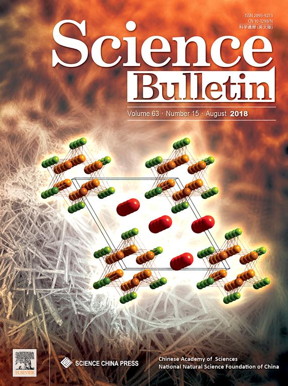Home > Press > Superconductivity above 10 K discovered in a novel quasi-one-dimensional compound K2Mo3As3
 |
| A research team led by Dr. Zhian Ren from Institute of Physics, Chinese Academy of Sciences discovered a quasi-one-dimensional superconductor K2Mo3As3, with the Tc value exceeding 10 K for the first time. This newly synthesized K2Mo3As3 crystallizes in a noncentrosymmetric hexagonal structure containing of (Mo3As3)2? linear chains, with bulk superconductivity confirmed via physical property characterizations. This discovery provides new platforms to study the underlying unconventional superconducting mechanism within the low-dimensional crystal structures. CREDIT ©Science China Press |
Abstract:
In the past century, superconductivity has been observed in thousands of substances with multifarious chemical compositions and crystal structures; however, researchers have still not found an explicit method for discovering new superconductors. For the unconventional high-Tc superconductors of cuprates and iron pnictides/chalcogenides, the occurrence of superconductivity is highly related to the existence of some certain quasi-two-dimensional structural motifs, e.g., the CuO2 planes or the Fe2As2/Fe2Se2 layers. Thus, low dimensionality has generally been considered as a favorable ingredient for exotic electron pairing due to the enhancement of electronic correlations. While among the quasi-one-dimensional (Q1D) compounds, only a few compounds were found to be superconducting at considerably low temperatures of several degrees Kelvin.
Superconductivity above 10 K discovered in a novel quasi-one-dimensional compound K2Mo3As3
Beijing, China | Posted on August 10th, 2018Recently, a team led by Prof. Zhian Ren from the Institute of Physics, Chinese Academy of Sciences discovered a Q1D superconductor K2Mo3As3, with a Tc value exceeding 10 K for the first time. Although lots of molybdenum chalcogenide superconductors were discovered from the 1970's, ternary compounds of molybdenum arsenide have rarely been reported. After many efforts on studying Mo-based ternary phases, the team succeeded in synthesizing the new K2Mo3As3 compound, which crystalizes in a noncentrosymmetric hexagonal structure with typical Q1D (Mo3As3)2- linear chains separated by K+ cations, similar to the structure of K2Mo3As3. Bulk superconductivity below 10.4 K was confirmed by electrical resistivity, magnetic susceptibility, and heat capacity measurements. The K2Mo3As3 is the first MoAs-based superconductor and possesses the record Tc in all Q1D superconductors. This discovery indicates that Cr and Mo based Q1D superconductors may share some common underlying origins within the similar structural motifs and will help to uncover the exotic superconducting mechanism in low dimensional materials.
####
For more information, please click here
Contacts:
Zhian Ren
Copyright © Science China Press
If you have a comment, please Contact us.Issuers of news releases, not 7th Wave, Inc. or Nanotechnology Now, are solely responsible for the accuracy of the content.
| Related Links |
| Related News Press |
Superconductivity
News and information
![]() Researchers develop molecular qubits that communicate at telecom frequencies October 3rd, 2025
Researchers develop molecular qubits that communicate at telecom frequencies October 3rd, 2025
![]() Next-generation quantum communication October 3rd, 2025
Next-generation quantum communication October 3rd, 2025
![]() "Nanoreactor" cage uses visible light for catalytic and ultra-selective cross-cycloadditions October 3rd, 2025
"Nanoreactor" cage uses visible light for catalytic and ultra-selective cross-cycloadditions October 3rd, 2025
Possible Futures
![]() Spinel-type sulfide semiconductors to operate the next-generation LEDs and solar cells For solar-cell absorbers and green-LED source October 3rd, 2025
Spinel-type sulfide semiconductors to operate the next-generation LEDs and solar cells For solar-cell absorbers and green-LED source October 3rd, 2025
Discoveries
![]() Researchers develop molecular qubits that communicate at telecom frequencies October 3rd, 2025
Researchers develop molecular qubits that communicate at telecom frequencies October 3rd, 2025
![]() Next-generation quantum communication October 3rd, 2025
Next-generation quantum communication October 3rd, 2025
![]() "Nanoreactor" cage uses visible light for catalytic and ultra-selective cross-cycloadditions October 3rd, 2025
"Nanoreactor" cage uses visible light for catalytic and ultra-selective cross-cycloadditions October 3rd, 2025
Announcements
![]() Rice membrane extracts lithium from brines with greater speed, less waste October 3rd, 2025
Rice membrane extracts lithium from brines with greater speed, less waste October 3rd, 2025
![]() Researchers develop molecular qubits that communicate at telecom frequencies October 3rd, 2025
Researchers develop molecular qubits that communicate at telecom frequencies October 3rd, 2025
![]() Next-generation quantum communication October 3rd, 2025
Next-generation quantum communication October 3rd, 2025
![]() "Nanoreactor" cage uses visible light for catalytic and ultra-selective cross-cycloadditions October 3rd, 2025
"Nanoreactor" cage uses visible light for catalytic and ultra-selective cross-cycloadditions October 3rd, 2025
Interviews/Book Reviews/Essays/Reports/Podcasts/Journals/White papers/Posters
![]() Spinel-type sulfide semiconductors to operate the next-generation LEDs and solar cells For solar-cell absorbers and green-LED source October 3rd, 2025
Spinel-type sulfide semiconductors to operate the next-generation LEDs and solar cells For solar-cell absorbers and green-LED source October 3rd, 2025
![]() Rice membrane extracts lithium from brines with greater speed, less waste October 3rd, 2025
Rice membrane extracts lithium from brines with greater speed, less waste October 3rd, 2025
|
|
||
|
|
||
| The latest news from around the world, FREE | ||
|
|
||
|
|
||
| Premium Products | ||
|
|
||
|
Only the news you want to read!
Learn More |
||
|
|
||
|
Full-service, expert consulting
Learn More |
||
|
|
||








